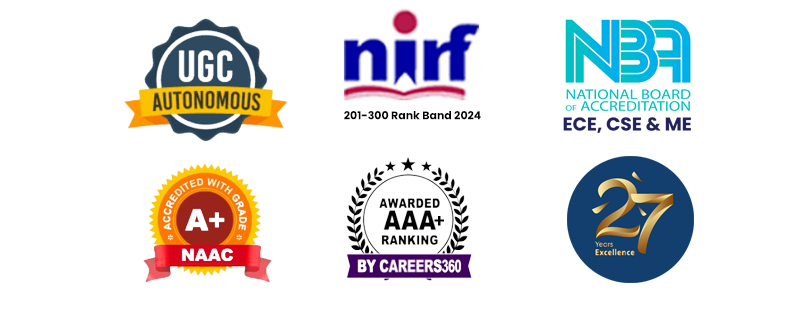Course Outcome Assessment Process
The Key aspects in Outcome-Based Education (OBE) are the assessment of Course Outcomes. At the initial stage of OBE implementation, the Course Outcomes (COs) for each course are defined based on the Program Outcomes (POs) and other requirements. At the end of each course, the COs need to be assessed and evaluated to check whether they have been attained or not.
The process of attainment of COs, POs and PSOs starts from writing appropriate COs for each course of the program from first year to fourth year in a four-year engineering degree program. The course outcomes are written by the respective faculty member using action verbs of learning levels suggested by Bloom and Anderson. Then, a correlation is established between COs and POs in the scale of 1 to 3, 1 being the slight (low), 2 being moderate (medium) and 3 being substantial (high). A mapping matrix is prepared in this regard for every course in the program including the elective subjects. The course outcomes written and their mapping with POs are reviewed frequently by a committee of senior faculty members before they are finalized.
Assessment is one or more processes carried out by the department, which identify, collect and prepare data to evaluate the achievement of POs and Program Specific Outcomes (PSOs). Attainment is the action or fact of achieving a standard result towards accomplishment of desired goals. Primarily attainment is the standard of academic attainment as observed by examination results.
Course Outcomes (COs): Statements indicating what a student can do after the successful completion of a course. Every Course leads to some Course Outcomes. The CO statements are defined by considering the course content covered in each module of a course. For every course there may be 5 or 6 COs. The keywords used to define COs are based on Bloom’s Taxonomy
Attainment of the COs can be measured directly and indirectly. Direct attainment displays the student’s knowledge and skills from their performance. It can be determined from the performance of the students in all the relevant assessment instruments like internal assessments, assignments, quiz and final examinations. These methods provide a sampling of what students know and/or can do and provide strong evidence of student learning.
Indirect methods such as Course End Surveys ask the students to reflect on their learning. They access opinions or thoughts about the graduate’s knowledge or skills. Indirect measures can provide information about graduate’s perception of their learning and how this learning is valued by different stakeholders. The entire assessment process is depicted in the following Figure

CO Attainment Calculation Process
Assessment Process for CO Attainment:
For the evaluation and assessment of CO’s and PO’s, rubrics are used. The rubrics considered here are given below:
Course Outcome is evaluated based on the performance of students in internal assessments and in End examination of a course. Internal assessment contributes10% and End examinations assessment contributes 90% to the total attainment of a CO.
After measuring CO attainment for a course, CO-PO mapping table will give Program Outcome attainment levels.
The Program outcomes (PO’s) are defined by NBA, New Delhi which are mandatory.
Program Outcomes (POs): Program outcomes describe what students are expected to know and would be able to do by the time of graduation. These relate to the skills, knowledge, and behaviors that students acquire as they progress through the program.
- PO 1 : Engineering Knowledge: Apply the knowledge of mathematics, science, engineering fundamentals, and an engineering specialization to the solution of complex engineering
- PO 2 : Problem Analysis: Identify, formulate, research literature, and analyze complex engineering problems reaching substantiated conclusions using first principles of mathematics, natural sciences, and engineering
- PO 3 : Design/Development of Solutions : Design solutions for complex engineering problems and design system components or processes that meet the specified needs with appropriate consideration for the public health and safety, and the cultural, societal, and environmental
- PO 4 : Conduct Investigations of Complex Problems : Use research-based knowledge and research methods including design of experiments, analysis and interpretation of data, and synthesis of the information to provide valid
- PO 5 : Modern Tool Usage : Create, select, and apply appropriate techniques, resources, and modern engineering and IT tools including prediction and modelling to complex engineering activities with an understanding of the
- PO 6 : The Engineer and Society : Apply reasoning informed by the contextual knowledge to assess societal, health, safety, legal and cultural issues and the consequent responsibilities relevant to the professional engineering
- PO 7 : Environment and Sustainability : Understand the impact of the professional engineering solutions in societal and environmental contexts, and demonstrate the knowledge of, and need for sustainable
- PO 8 : Ethics : Apply ethical principles and commit to professional ethics and responsibilities and norms of the engineering
- PO 9 : Individual and Team Work : Function effectively as an individual, and as a member or leader in diverse teams, and in multidisciplinary
- PO 10 : Communication : Communicate effectively on complex engineering activities with the engineering community and with society at large, such as, being able to comprehend and write effective reports and design documentation, make effective presentations, and give and receive clear
- PO 11 : Project Management and Finance : Demonstrate knowledge and understanding of the engineering and management principles and apply these to one’s own work, as a member and leader in a team, to manage projects and in multidisciplinary
- PO 12 : Life-Long Learning : Recognize the need for, and have the preparation and ability to engage in independent and life-long learning in the broadest context of technological
Apart from the PO’s every department has liberty to define its own Program Specific Outcomes (PSO’s).
Program Specific Outcomes (Program has to specify 2 – 4 PSOs)
Program Specific Outcomes are statements that describe what the graduates of a specific engineering program should be able to do.
Process involved in CO-PO Mapping
The role of CO-PO mapping will be assigned to the faculty as per hierarchy. After the course (subject) allotment from the department, the course in-charge of the course has to write appropriate COs for their corresponding course. It should be narrower and measurable statements. By using the action verbs of learning levels, CO’s will be designed. CO statements should describe what the students are expected to know and able to do at the end of each course, which are related to the skills, knowledge and behaviour that students will acquire through the course.
After writing the CO statements, CO will be mapped with PO of the department. If the department is having more than one section in a year or the same course is available for more than one program of the same institute in a semester, the subject expert will be nominated as course coordinator of the corresponding course. The role of the course coordinator is to review the CO statements and the CO-PO mapping which has been done by course in-charge. The year wise coordinator has to consolidate the CO’s of the respective year and maintain the documentation of the CO attainment level of the respective year courses as well as documentation of the individual students extra-curricular and co-curricular activities. These details will hand over to the program coordinator in order to evaluate PO attainment of the individual student as well as individual course at the end of the eighth semester. The Program coordinator has to evaluate the PO attainment of individual student through direct and indirect method after the student completing their program. All these works have to be done under the guidance of Department Advisory Committee (DAC).
Following are the different methods for Assessment, Evaluation and Measurement of POs/PSOs
Direct Assessment methods
Indirect Assessment methods
Direct Assessment methods:
Continuous Assessment: COs are assessed through Sessional & Assignment Examinations and Lab records. The COs are mapped against each question and CO analysis is carried out by faculty for each course and documented. The contribution of COs are assessed in high, moderate and low levels, towards the attainment of POs/PSOs.
Semester-end Theory Examinations: The questions in semester-end examinations are tested pertaining to all COs, in varying Blooms Taxonomy Levels.
Laboratory Records: Both continuous and semester-end examinations are conducted to test the COs attainment.
Indirect Assessment Methods:
Programme – Exit survey: This survey taken from the final year students at the completion of their B.Tech programme, stands as the comprehensive feedback for the PO/PSO assessment
Alumni Survey: This survey is conducted annually through Google link or mail with the Alumni to obtain the inputs and suggestions on PO attainment in the real time societal environment
Employer Survey: This survey is taken from the employer to measure the PO attainments.
External Examination Assessment Process:
Rubrics:
If 50% of the students crossed 50% of the marks: Attainment Level 1
If 60% of the students crossed 50% of the marks: Attainment Level 2
If 70% of the students crossed 50% of the marks: Attainment Level 3

Internal Examination Assessment Process:


| CO Attainment | |||||
|---|---|---|---|---|---|
| COs | CO Attainment Level (Mid) |
CO Attainment Level (External) |
Direct CO Attainment Level (Internal * 30%) + (External * 70%) |
Indirect CO Attainment Level |
Total CO Attainment Level (Direct CO Attainment * 90% + Indirect CO Attainment * 10%) |
| C323.1 | 1 | 2 | 1.7 | 3 | 1.83 |
| C323.2 | 1 | 3 | 2.4 | 3 | 2.46 |
| C323.3 | 3 | 2 | 2.3 | 3 | 2.37 |
| C323.4 | 3 | 3 | 3 | 3 | 3.00 |
| C323.5 | 3 | 2.2 | 2.44 | 3 | 2.50 |
| C323 | 2.43 | ||||
FORMULATION OF COURSE ARTICULATION MATRIX: Course Articulation Matrix correlates the individual COs of a course with POs and PSOs. The strength of correlation is indicated as 3 for substantial (high) 2 for correlation, moderate (medium) correlation, and 1 for slight (low) correlation.
After measuring CO attainment for a course, CO-PO mapping table will give Program Outcome attainment levels. A typical CO-PO mapping table and CO-PSO mapping tables are shown below.
| CO-PO Mapping | ||||||||||||
|---|---|---|---|---|---|---|---|---|---|---|---|---|
| COs | POs | |||||||||||
| PO1 | PO2 | PO3 | PO4 | PO5 | PO6 | PO7 | PO8 | PO9 | PO10 | PO11 | PO12 | |
| C323.1 | 1 | 2 | 2 | 3 | 3 | – | – | – | – | – | – | – |
| C323.2 | 1 | 2 | 2 | 3 | 3 | – | – | – | – | – | – | – |
| C323.3 | 3 | 2 | 3 | 3 | 3 | – | – | – | – | – | – | – |
| C323.4 | 3 | 3 | 3 | 3 | 3 | – | – | – | – | – | – | – |
| C323.5 | 3 | 3 | 3 | 3 | 2 | – | – | – | – | – | – | – |
| C323 | 2.2 | 2.4 | 2.6 | 3 | 2.8 | – | – | – | – | – | – | – |
| CO-PSO Mapping | |||
|---|---|---|---|
| COs | PSOs | ||
| PSO1 | PSO2 | PSO3 | |
| C323.1 | – | 3 | 3 |
| C323.2 | – | 3 | 3 |
| C323.3 | – | 3 | 3 |
| C323.4 | – | 3 | 3 |
| C323.5 | – | 3 | 3 |
| C323 | – | 3 | 3 |
PO attainment process is depicted in the following figure.

Based on final attainment of Course Outcomes and mapping of each Course Outcome with Program Outcomes and Program Specific Outcomes, final attainment of Program Outcomes and Program Specific Outcomes are measured as shown in the following tables.
| Total CO Attainment through Direct & Indirect Assessment | ||||||||||||
|---|---|---|---|---|---|---|---|---|---|---|---|---|
| CO Attainment | 2.43 | |||||||||||
| PO Attainment | ||||||||||||
| PO1 | PO2 | PO3 | PO4 | PO5 | PO6 | PO7 | PO8 | PO9 | PO10 | PO11 | PO12 | |
| PO Attainment |
1.78 | 1.94 | 2.11 | 2.43 | 2.27 | – | – | – | – | – | – |
– |
|
PSO Attainment |
|||
|
COs |
PSOs |
||
|
PSO1 |
PSO2 |
PSO3 |
|
|
PSO |
– |
2.43 |
2.43 |

FORMULATION OF PROGRAMME ARTICULATION MATRIX:
Program Outcomes attainment based on CO direct attainment as shown below.
Mapping of Courses with POs and PSOs is known as Programme Articulation Matrix

The eleven steps towards validation of POs are as follows:
Step 1: Defining the Vision and Mission of the Department.
Step 2: Defining Program Educational Objectives (PEOs) of the Department.
Step 3: Establishing POs to setup target level of PO attainment.
Step 4: Defining relation between Course Outcomes (COs) and POs for each course to obtain overall CO mapping with each POs.
Step 5: Development of overall CO-PO mapping matrix for all courses.
Step 6: Computation and construction of overall CO attainment matrix for each course using course assessment tools.
Step 7: Calculation and construction of direct PO attainment matrix using overall CO-PO mapping matrix and overall CO attainment matrix.
Step 8: Calculation of overall direct PO attainment.
Step 9: Calculation of indirect PO attainment.
Step 10: Computation of overall PO attainment.
Step 11: Comparison of target level and obtained PO attainment.





